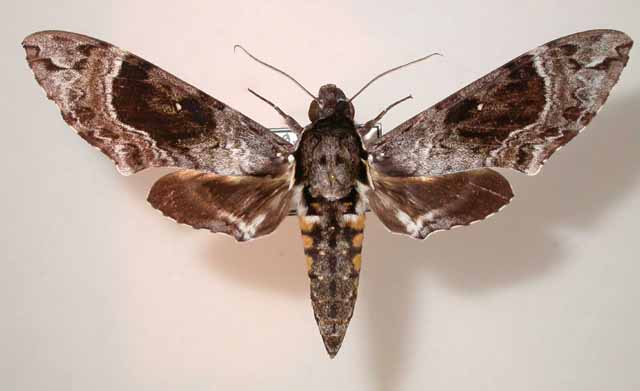Manduca brunalba
Manduca brunalba
man-DOO-kuhmm BROON-al-buh
(B. P. Clark, 1929) Protoparce

Manduca brunalba courtesy
of Jean Haxaire
This site has been created by Bill Oehlke.
Comments, suggestions and/or additional information are welcomed by Bill.
TAXONOMY:
Family: Sphingidae, Latreille, 1802
Subfamily: Sphinginae, Latreille, [1802]
Tribe: Sphingini, Latreille, 1802
Genus: Manduca Hubner, [1807] ...........
Species: brunalba (B. P. Clark, 1929)
|
DISTRIBUTION:
Manduca brunalba (approximate wingspan: 100-104mm)
flies in
Brazil (specimen type locality);
French Guiana: Kaw; Montsinery
Peru;
Venezuela. In
Bolivia it is recorded from Yocumo [Yacuma] (350m), Department of Beni.
It is likely also present in Suriname and Guyana.
The slightly darker tegulae are inwardly lined in thin black. On the centr of the thorax there are two small dark triangles.
The abdomen has three prominent orangey-yellow marks on each side and a dark mesial band, broken into segments.
The forewing median area is a blotchy dark brown in its upper 3/4 with a strong outward projection opposite the cell. There is a conspicuous, continuous
white postmedian band lining the outer edge of the median area. A dark irregular am line, more visible in its lower 2/3 is highlighted by white scaling on both sides.
FLIGHT TIMES:
Manduca brunalba adults fly in August in French Guiana and possibly in other months.
ECLOSION:
Pupae probably wiggle to surface from subterranean chambers just prior to eclosion.
SCENTING AND MATING:
Females call in the males with a pheromone released from a gland at the tip of the
abdomen. Adults take nectar from flowers.
EGGS, LARVAE, PUPAE:
Larval hosts are unknown by me.
Use your browser "Back" button to return to the previous page.
Return to Sphingidae Index
Return to Sphingini Tribe
This page is brought to you by Bill Oehlke and the
WLSS. Pages are on space rented from Bizland. If you would like
to become a "Patron of the Sphingidae Site", contact Bill.
Please send sightings/images to Bill. I will do my best to respond to requests for identification help.
 | 
Show appreciation for this site by clicking on flashing butterfly to the left.
The link will take you to a page with links to many insect sites. |


